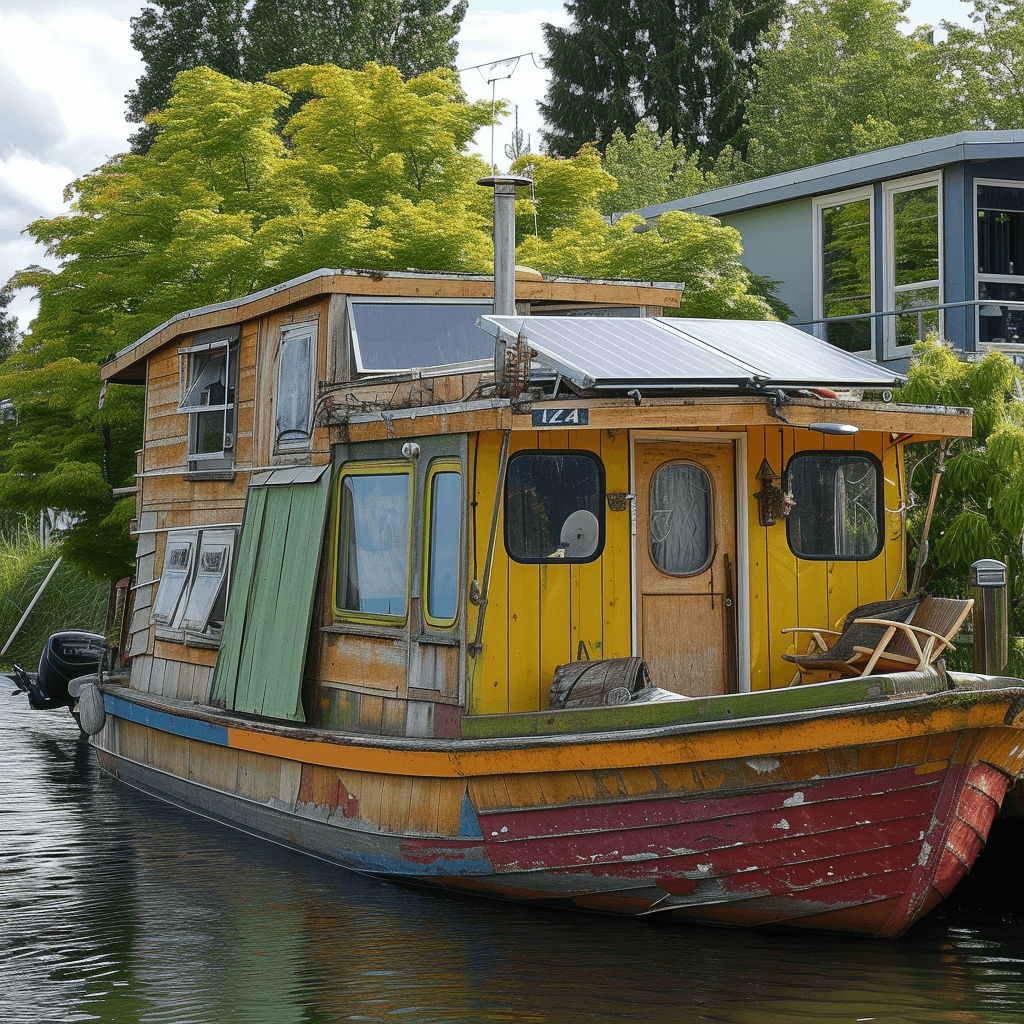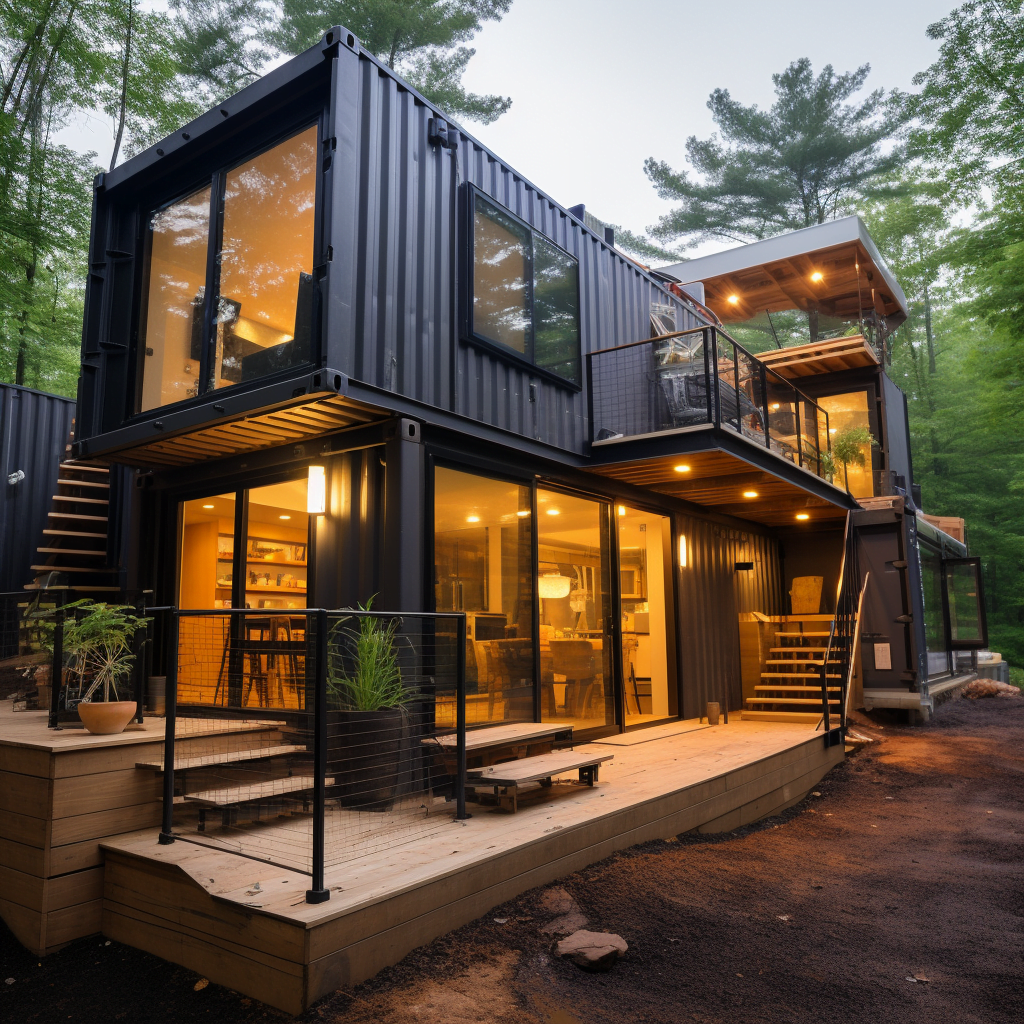Living in a shipping container has become an intriguing option for those seeking an alternative, minimalist lifestyle. With the rise of off-grid living and the appeal of repurposing materials, the question arises: Is it safe to live in a container? This article will explore the potential safety hazards and benefits of container living, considering factors such as structural integrity, health concerns, and environmental impact. By delving into the various aspects of this unconventional housing choice, we aim to provide a comprehensive evaluation of its safety and viability as a living option.
What is off-grid living?
Definition of off-grid living
Off-grid living refers to a lifestyle in which individuals or communities are completely self-sufficient and independent from public utilities such as electricity, water supply, and sewage systems. It involves relying on sustainable and alternative sources of energy, harvesting rainwater, and implementing various techniques to minimize waste and maximize efficiency. This lifestyle often involves living in remote areas, away from urban centers, and adopting sustainable practices that aim to reduce the negative impact on the environment.
Advantages of off-grid living
Off-grid living offers numerous advantages that have attracted a growing number of individuals seeking a sustainable and independent lifestyle. One of the key advantages is the ability to reduce living expenses. By producing their own energy and water, off-grid dwellers can significantly lower their utility bills. Additionally, off-grid living promotes self-sufficiency and resilience, as individuals have greater control over their resources and are less vulnerable to power outages or other disruptions in public utilities.
Moreover, off-grid living contributes to environmental preservation. By utilizing renewable energy sources such as solar panels or wind turbines, individuals can reduce their carbon footprint and minimize their impact on natural resources. This lifestyle also fosters a deeper connection to nature, as off-grid dwellers often embrace sustainable practices, such as organic gardening and composting, that promote environmental stewardship.
Disadvantages of off-grid living
Although off-grid living offers enticing benefits, it is not without its challenges and drawbacks. One of the major disadvantages is the initial cost of setting up an off-grid system. The installation of solar panels, wind turbines, and other sustainable technologies can be expensive. Furthermore, the maintenance and repair of these systems require specialized knowledge or professional assistance, which can add to the overall expenses.
Another challenge of off-grid living is the limited access to conveniences and amenities commonly found in urban areas. Off-grid dwellers may need to travel longer distances to retrieve supplies, access healthcare facilities, or connect with the broader community. Additionally, the lifestyle may require adjustments to daily routines, such as conserving resources and adapting to intermittent power availability.
Lastly, off-grid living can sometimes be socially isolating. Living in remote areas can limit social interactions and make it harder to access educational or recreational opportunities. Individuals considering off-grid living should carefully consider their social needs and the potential impact on their overall well-being.
The popularity of living in a container
Reasons for the growing popularity
In recent years, there has been a surge in the popularity of living in container homes, also known as shipping container homes. There are several reasons why this unconventional housing option is gaining traction among individuals seeking off-grid living.
Firstly, container homes provide a cost-effective solution for housing. Used shipping containers can be repurposed into dwelling units at a fraction of the cost of traditional housing construction. This affordability appeals to individuals who want to minimize their expenses and embrace a minimalist lifestyle.
Secondly, container homes are highly versatile and customizable. These shipping containers can be modified and combined to create unique living spaces that suit individual preferences. From single-container cabins to multi-story residences, the modular nature of container homes allows for creative design and flexibility in accommodating different needs.
Lastly, the environmental aspect of container homes adds to their appeal. By repurposing and reusing shipping containers, individuals are reducing the demand for new construction materials and minimizing waste. Container homes can be part of a broader sustainable lifestyle, particularly when combined with off-grid living practices and energy-efficient technologies.
Different types of container homes
Container homes come in various designs and configurations, making them adaptable to different climates and preferences. Some common types of container homes include:
- Single-container homes: These are compact living spaces created from a single shipping container. They often provide the basics required for comfortable living, such as a kitchenette, bathroom, and sleeping area.
- Multi-container homes: These are larger residences constructed by combining multiple shipping containers. By stacking or arranging the containers side by side, more spacious living areas can be achieved.
- Hybrid container homes: These homes combine shipping containers with traditional construction materials, such as wood or concrete, to create a unique blend of aesthetics and functionality. The combination of containers and conventional materials enables greater design possibilities.
- Container complexes: These are larger-scale projects that involve connecting and stacking numerous containers to create communities or commercial spaces. Container complexes can serve as off-grid living communities, offering shared resources and amenities to residents.

Cost-effectiveness of container homes
One of the primary factors contributing to the popularity of container homes is their cost-effectiveness. Building a container home can be significantly cheaper compared to traditional construction methods. Used shipping containers can often be acquired at a lower cost or even for free, depending on the availability in local markets. The initial cost savings can be substantial, especially when combined with off-grid living practices that further reduce ongoing utility expenses.
However, it is important to note that while container homes offer cost advantages, there are additional expenses involved in making them suitable for comfortable living. These expenses include insulation, interior finishing, plumbing, electrical systems, and modifications to ensure structural integrity. It is crucial to budget for these costs and work closely with professionals experienced in container building to achieve a safe and habitable living space.
Factors to consider before living in a container
Building codes and regulations
Before embarking on the journey of container living, it is essential to thoroughly research and understand local building codes and regulations. Building codes vary depending on the region and jurisdiction, and they often have specific requirements for dwellings constructed from shipping containers. These requirements may include considerations for structural integrity, fire safety, insulation, and plumbing. It is crucial to consult with local authorities or building professionals to ensure compliance with the applicable regulations and obtain the necessary permits for container home construction.
Location and climate considerations
The choice of location plays a significant role in the feasibility and comfort of living in a container home. Factors such as access to utilities, proximity to necessary services, and environmental conditions need to be carefully considered. It is essential to evaluate the availability of sunlight for off-grid energy production, as well as the availability of water sources for sustainable living. Additionally, the climate of the chosen location should be taken into account to ensure proper insulation and ventilation, as extreme temperatures or high humidity can affect the livability of container homes.
Structural integrity of containers
When considering container living, assessing the structural integrity of the shipping containers is of utmost importance. Containers are primarily designed to withstand the rigors of international shipping, but modifications made during conversion into homes can impact their structural strength. It is crucial to thoroughly inspect the containers for any signs of corrosion, damage, or weakness that may compromise their stability. Engaging a professional structural engineer or an experienced container builder can help ensure that appropriate reinforcement measures are implemented to guarantee the safety and longevity of the container home.
Safety concerns of living in a container
Fire safety
Fire safety is a significant concern when living in a container home. Shipping containers are primarily made of steel, which is not inherently fire-resistant. In the event of a fire, the steel can reach high temperatures and compromise the structural integrity of the container. Therefore, it is crucial to take precautions to minimize the risk of fire and ensure occupants’ safety.

Structural stability
The structural stability of container homes is another important safety consideration. While containers are designed to withstand heavy loads and stacking during transportation, modifying them for habitation involves cutting openings for doors, windows, and ventilation. These modifications can weaken the overall structure if not done properly, potentially leading to structural failures or collapses. Proper reinforcement and expertise in container construction are vital to ensure the structural stability of container homes.
Insulation and ventilation
Insulation and ventilation are crucial aspects of container homes to maintain comfortable living conditions and prevent health issues such as mold growth and condensation. Containers have minimal insulation properties, making them vulnerable to extreme temperatures. Proper insulation, such as spray foam or rigid insulation panels, should be considered to prevent heat loss or gain and minimize energy consumption. Adequate ventilation systems, including windows, vents, and fans, must be installed to ensure proper airflow and remove moisture to prevent the buildup of condensation and potential health risks.
Health risks
Living in a container home may present certain health risks that need to be addressed. Potential exposure to toxic materials, such as chemicals from container treatments or residual pollutants from shipping cargo, can pose health hazards if not properly mitigated. Proper cleaning, sealing, and applying suitable non-toxic coatings to the interior of the containers are essential steps to reduce the risk of exposure. Additionally, pest control measures should be in place to prevent infestations that could affect occupants’ health. It is also crucial to prioritize indoor air quality by selecting low-emission materials and implementing adequate ventilation to ensure a healthy living environment.
Fire safety considerations
Fire-resistant materials
To enhance fire safety in container homes, the use of fire-resistant materials is crucial. Non-combustible materials such as gypsum boards or cement boards can be used for interior walls and ceilings to mitigate the spread of fire. Additionally, fire-resistant coatings or paints can be applied to the container exterior to increase fire resistance. The selection of fire-resistant materials should be done in accordance with local building codes and regulations to ensure compliance and maximize the safety of the occupants.
Escape routes
Having proper escape routes is essential in case of a fire emergency. Container homes should have multiple, clearly marked exits that lead directly to the exterior. These exits should be easily accessible and unobstructed at all times. Additionally, fire safety ladders or other means of egress should be provided for multi-story container homes to ensure safe evacuation from higher levels. Regular fire drills and familiarization with escape routes are also essential to ensure that all occupants know how to respond in case of a fire emergency.

Fire prevention and protection measures
Preventing fires is key to ensuring the safety of container homes. This includes installing smoke detectors, fire alarms, and fire extinguishers in strategic locations throughout the living space. Regular maintenance and testing of these devices should be conducted to ensure their proper functioning. Furthermore, implementing fire-safe practices, such as proper storage of flammable materials and adhering to safe cooking practices, can significantly reduce the risk of fires. Adequate fire protection measures should be incorporated during the construction phase, including the installation of fire-resistant barriers and fireproof insulation materials.
Structural stability of container homes
Foundation and anchoring
The foundation and anchoring of container homes are crucial for structural stability. Containers should be properly leveled and secured to a solid foundation to prevent shifting or settling. Depending on the soil conditions and local building regulations, a foundation can be constructed using concrete footings, piers, or a concrete slab. Adequate support structure and anchoring mechanisms, such as steel reinforced beams or screw piles, should be utilized to ensure the containers remain stable during extreme weather conditions or seismic events.
Weatherproofing
To protect container homes from the elements, weatherproofing measures should be implemented. Containers are susceptible to corrosion, especially in coastal or humid regions, so proper sealing and coating should be applied to prevent water infiltration and rusting. Exterior cladding, such as wood, metal panels, or stucco, can be added to improve insulation and enhance the aesthetic appeal of the dwelling. Weatherproofing measures should be tailored to the specific climate and environmental conditions of the chosen location to ensure long-lasting structural integrity.
Structural modifications
Container homes often require structural modifications to create suitable living spaces. Any modifications made to the containers should be carefully planned and implemented to avoid compromising their structural integrity. Openings for doors, windows, and other utilities should be cut in a way that distributes the load evenly and maintains the container’s strength. Proper reinforcement, such as the addition of steel beams or columns, should be incorporated to compensate for any structural weaknesses created by the modifications. Engaging professionals experienced in container construction is crucial to ensure that the necessary modifications are done safely and effectively.
Importance of insulation and ventilation
Proper insulation materials
Insulation is essential for container homes to maintain comfortable living conditions and energy efficiency. Containers have minimal insulation properties due to their metal construction, making them susceptible to temperature extremes. Proper insulation materials, such as spray foam insulation or rigid insulation panels, should be installed in the walls, floor, and ceiling to prevent heat loss during winters and heat gain during summers. It is crucial to select insulation materials with suitable R-values, accounting for the specific climate and thermal requirements of the region.
Ventilation systems and air quality
Adequate ventilation is crucial in container homes to ensure a healthy living environment and prevent the buildup of moisture, stale air, and pollutants. Ventilation systems should provide a constant exchange of fresh air while expelling stale air and controlling humidity levels. Windows, skylights, and vents should be strategically placed to facilitate airflow and enable cross-ventilation. Mechanical ventilation systems, such as fans or heat recovery ventilators, can further improve air quality by removing indoor pollutants and introducing filtered fresh air. Regular maintenance and cleaning of ventilation systems are essential to ensure their optimal performance.
Prevention of mold and condensation
Proper insulation and ventilation are key factors in preventing mold growth and condensation issues in container homes. Insufficient insulation or inadequate ventilation can lead to condensation buildup on interior surfaces, creating a favorable environment for mold growth and compromising air quality. Mold can cause various health issues, including respiratory problems and allergies, therefore it is crucial to take preventive measures. These may include applying mold-resistant coatings or paints, using materials with moisture-resistant properties, and implementing proper ventilation strategies to remove excess moisture and maintain a healthy living environment.
Health risks associated with container living
Potential exposure to toxic materials
Container homes have the potential for exposure to toxic materials due to the origin and previous use of the shipping containers. Containers may have been treated with chemicals to protect them during transportation, and residual pollutants from shipping cargo can still be present. Proper cleaning and sealing of the container interior are essential to minimize exposure to these potential toxins. Choosing containers that have not been used for hazardous materials transport or opting for new containers can further reduce the risk of exposure.
Pest control and prevention
Controlling pests in container homes is crucial for health and safety. Shipping containers, especially those stored in outdoor areas, can attract pests such as rodents, insects, or termites. Thoroughly inspecting and sealing any potential entry points in the container is an important preventive measure. Additionally, implementing pest control strategies such as regular cleaning, proper waste disposal, and limited food storage can help minimize the risk of infestations. It is important to consult with professionals in pest control to develop an effective and sustainable pest management plan tailored to the specific container home.
Indoor air quality
Maintaining good indoor air quality is essential for the overall well-being of container home occupants. Building materials used in container homes, such as paints, adhesives, or flooring, can emit volatile organic compounds (VOCs) that can affect indoor air quality. It is important to select low-emission or VOC-free materials to minimize exposure to harmful pollutants. Adequate ventilation, as previously discussed, should be established to remove indoor pollutants and introduce fresh air. Regular cleaning with non-toxic cleaning products and proper ventilation can help maintain a healthy indoor living environment.
Alternative housing options for off-grid living
Tiny houses
Tiny houses have gained immense popularity as an alternative housing option for off-grid living. These compact dwellings are typically between 100 and 400 square feet and are designed to maximize functionality and minimize environmental impact. The small size of tiny houses encourages a minimalist lifestyle and helps reduce energy consumption and living expenses. Tiny houses can be constructed on or off foundations, offering flexibility in terms of location and mobility. They often incorporate sustainable features like solar panels, rainwater harvesting systems, and composting toilets, aligning with the principles of off-grid living.
Earthship homes
Earthship homes are another alternative housing option for off-grid living that promotes self-sufficiency and eco-friendliness. These unique homes are constructed using recycled materials, such as tires, bottles, and cans, which are filled with compacted earth to create thermal mass. Earthship homes are designed to be passive solar structures, utilizing large south-facing windows to harness solar energy for heating and lighting. They also incorporate sustainable water management systems, such as rainwater collection and filtration, as well as natural ventilation and wastewater treatment systems. Earthship homes provide a self-contained and sustainable living environment that reduces reliance on external resources.
Geodesic dome homes
Geodesic dome homes are characterized by their strong and efficient structural design. These homes are constructed using interconnected triangular panels that form a spherical or hemispherical shape. The geodesic structure provides superior structural integrity and can withstand extreme weather conditions. Geodesic dome homes offer a unique living space with a spacious interior and a minimal amount of materials required for construction. They can be customized to include sustainable features such as solar panels, rainwater harvesting systems, and passive ventilation. The efficient use of space and low construction costs make geodesic dome homes an attractive option for off-grid living.
Conclusion
Off-grid living offers individuals the opportunity to lead sustainable, self-sufficient lifestyles away from the constraints of traditional urban areas. Container homes have gained popularity as an alternative housing option for off-grid living due to their cost-effectiveness, versatility, and environmental benefits. However, various factors need to be considered before embracing container living, including local building codes and regulations, location and climate considerations, and structural integrity. Safety concerns relating to fire safety, structural stability, insulation, and ventilation must be addressed to ensure the well-being of occupants. Additionally, potential health risks associated with container living should be mitigated through proper maintenance, ventilation, and selection of non-toxic materials.
While container homes offer a unique and appealing off-grid living option, alternative housing options like tiny houses, earthship homes, and geodesic dome homes also cater to individual preferences and lifestyle choices. It is crucial for individuals to weigh the pros and cons of each option, considering factors such as affordability, environmental impact, available resources, and personal preferences. By carefully considering these factors and conducting thorough research, individuals can make informed decisions in pursuit of a fulfilling and sustainable off-grid lifestyle.



